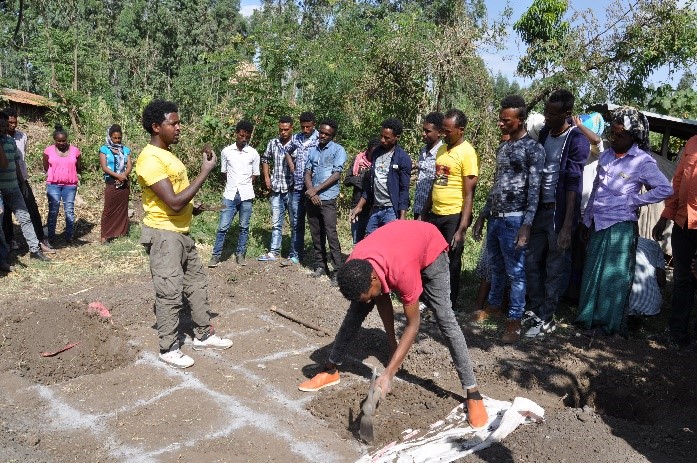“We Have Vegetables at Every Meal”: a Perma-Garden Takes Root

How do you build the resilience of households that have no access to formal markets, limited access to productive farmland, whose livelihood is at the mercy of recurrent droughts, and who rely on the government’s safety net just to survive from season to season?
Start a perma-garden
The USAID/Feed the Future Livelihoods for Resilience Activity has introduced a technique called perma-gardening[1] to households in the highlands of Ethiopia to help them maximize the productivity of a small amount of land. The participants in the project are part of the government’s Productive Safety Nets Project 4 (PSNP4) safety net program, which provides vital assistance to food insecure households in Ethiopia. PSNP4 addresses chronic food insecurity through the provision of transfers, public works that rehabilitate natural resources and address community needs, linkages to social services and livelihoods support. The Livelihoods for Resilience Activity is USAID’s contribution to the livelihoods component of the PSNP4 and is designed to complement and support implementation of livelihoods activities along three pathways: crops and livestock, off-farm and wage employment. The Project builds on the lessons learned from a predecessor project, Graduation with Resilience to Achieve Sustainable Development (GRAD).
In the rural highlands of Ethiopia, land degradation and recurrent droughts combined with population growth have led poorer households to farm increasingly marginal land, making it difficult for them to feed their families year-round and increasing their dependence on safety nets. In this context, CARE and partners have introduced a technique called perma-gardening, which enables farmers to produce vegetables throughout the year using sustainable practices that improve soil fertility and conserve water.
Using locally available materials such as ash, charcoal and grass to make compost, CARE and partners teach rural farmers perma-garden design, water management strategies and preparation of compost. A core principle is capturing rainwater that would otherwise be lost as run-off and "storing" it in the sub-soil. The technique involves deep digging plots and also digging four holes about 70 cm wide at the corner of each garden to collect roof water.
Shimber Ayalew, a 28-year-old mother of two, and her husband, Degu Kassamre, live in the Amhara Region of Ethiopia. They participated in perma-gardening training provided by the Project, installed a perma-garden at their home, and have seen a transformational change in both their income and their consumption of nutritious food. After just three months of using the technique, Shimber reflects that, “It was so difficult to get fresh vegetables from weekly market days. Even when we sometimes bought the vegetables at a high price, keeping them fresh for a week was a challenge. Before we knew about perma-gardening, we only planted crops such as teff and barley on our land.”
Shimber shares that learning perma-gardening “...was very practical. I took it with my husband and my VESA members with the support of a perma-garden trainer and community facilitators. We learned how to prepare and care for a perma-garden on a small plot of land,” she says. As part of the training, Shimber’s family allocated a 16 sq. meter plot of land to the perma-garden. In the first round, Shimber planted four types of nutritious vegetables: chard, kale, carrot and beet root.
The results of using the technique have been life changing. Shimber harvests chard and kale every day, and the family, including their two-year-old son, have fresh vegetables at every meal. Shimber also harvests enough to sell surplus vegetables at the market. “So far, I earned a total of 200 birr from the sale of chard. I buy eggs for my sons from the income so that they get even more nutritious food in their diet.” Degu, Shimber’s husband, recalls that, “A few months ago our meals were dominated by shiro (a sauce made from beans or peas). Now we are so happy to have vegetables in our meals every day. We expect to harvest more as we are still waiting for the carrot and beet root harvest. Witnessing our success, some of our neighbors requested that we show them how to prepare their gardens, and we are happy to do that as much as we can.”
According to Dinku Daniel, the Project’s perma-gardening training facilitator, any household with a small plot of land can create a perma-garden. Applying the technique conserves water for vegetable production and uses precious natural resources more efficiently. In one woreda, 480 households received training on perma-gardening, 130 of which started harvesting vegetables within months of applying the technique to their plots. Due to the success and adoption of the technique among community members, community facilitators and extension promoters are cascading the training to thousands of households in 27 project woredas.
 Perma-garden training
For Shimber and her husband the most exciting thing about perma-gardening is the possibility of harvesting more from small plots of land throughout the year to sustain their food security.
Perma-garden training
For Shimber and her husband the most exciting thing about perma-gardening is the possibility of harvesting more from small plots of land throughout the year to sustain their food security.
[1] Perma-gardening was introduced to CARE by Peter Jensen of Terra Firma Intl.
